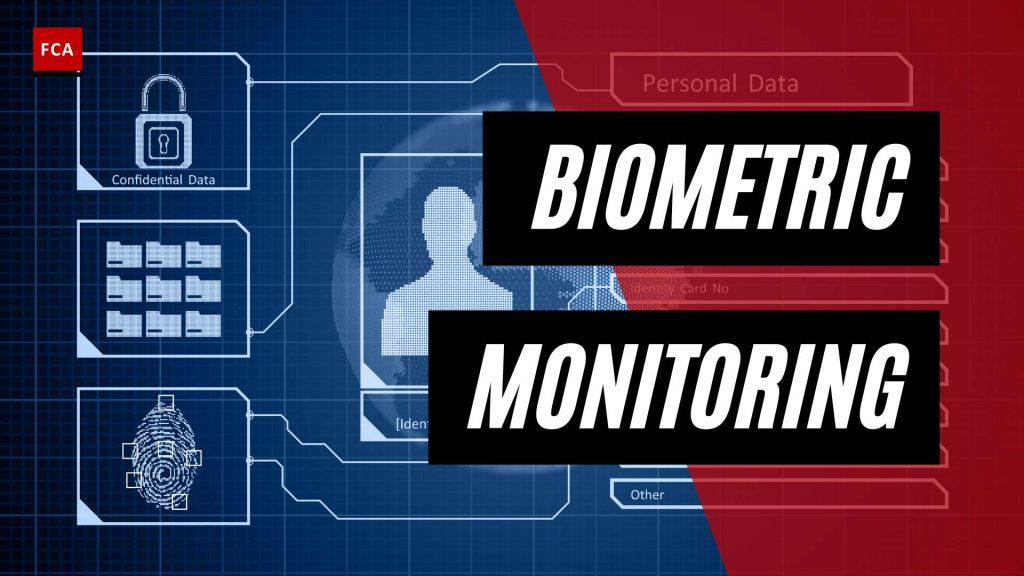Biometric Transaction Monitoring: Enhancing Financial Security
In the realm of financial security, biometric transaction monitoring has emerged as a powerful tool for enhancing security measures and preventing fraud. By utilizing biometric data, such as fingerprints or facial recognition, this technology adds an extra layer of protection to financial transactions, ensuring the authenticity and integrity of each interaction.
The Role of Biometric Transaction Monitoring
The primary role of biometric transaction monitoring is to verify the identity of individuals during financial transactions. Traditional methods of authentication, such as passwords or PIN codes, can be vulnerable to theft or misuse. Biometric authentication, on the other hand, relies on unique physical or behavioral characteristics that are inherently difficult to replicate, providing a high level of assurance in verifying a person’s identity (Thomson Reuters).
By analyzing biometric data, financial institutions can ensure that only authorized individuals are granted access to their accounts and allowed to perform transactions. This significantly reduces the risk of unauthorized access, identity theft, and various forms of financial fraud (TechTarget).
Advantages of Biometric Authentication
Biometric authentication offers several advantages over traditional authentication methods. Firstly, it provides a higher level of security and accuracy. Biometric traits, such as fingerprints, face patterns, or iris scans, are unique to each individual and difficult to replicate. The probability of two fingerprints matching exactly is estimated to be one in 64 billion, making them near spoof-proof. This uniqueness makes it significantly more challenging for fraudsters to bypass biometric security measures.
Secondly, biometric authentication offers convenience and efficiency for users. Instead of remembering complex passwords or PIN codes, users can simply use their own biometric traits to authenticate their identity. This eliminates the need for memorization and reduces the risk of forgotten passwords. Placing a finger on a scanner or looking at a facial recognition camera takes only seconds, making the authentication process faster and more user-friendly.
Convenience and Efficiency of Biometric Authentication
In addition to its security benefits, biometric authentication also offers convenience and efficiency for users. Biometric traits are non-transferable, meaning the physical presence of the individual is required for authentication. This eliminates the possibility of sharing or transferring credentials, enhancing the overall security of the system.
Furthermore, biometric authentication is well-suited for a variety of devices and applications. It can be seamlessly integrated into smartphones, tablets, and other electronic devices, allowing users to access their financial accounts with ease. The widespread adoption of biometric authentication in various sectors, such as unlocking smartphones or securing financial transactions, demonstrates its convenience and efficiency in real-world applications (LinkedIn).
As financial institutions strive to stay one step ahead of fraudsters, biometric transaction monitoring plays a crucial role in enhancing financial security. By leveraging the unique characteristics of individuals, biometric authentication provides a robust and reliable means of verifying identities and preventing unauthorized transactions. With its advantages in security, convenience, and efficiency, biometric authentication is poised to become an integral component of future financial systems.
Biometric Technologies for Transaction Monitoring
When it comes to biometric transaction monitoring, several biometric technologies are utilized to enhance security and verify the identities of individuals during financial transactions. These technologies include fingerprint verification, facial recognition, and iris scanning.
Fingerprint Verification
Fingerprint verification is one of the most commonly used biometric technologies for transaction monitoring. This involves capturing the unique patterns and ridges on an individual’s fingertips to create a digital representation of their fingerprints. The captured fingerprint data is then compared to a database of pre-registered fingerprints to verify the identity of the individual.
Fingerprint verification is highly accurate and near impossible to replicate with current technology. The chance of a fingerprint matching exactly with someone else’s is as low as one in 64 billion, making it a reliable method for authentication (Mitek Systems). The convenience of placing a finger on a scanner for authentication is also favored by users, as it is faster than typing out a password and less likely to be forgotten (Mitek Systems).
Facial Recognition
Facial recognition technology analyzes and identifies unique facial features to verify an individual’s identity. It captures various facial characteristics such as the distance between the eyes, nose shape, and jawline. This technology then compares the captured facial data with a database of pre-registered facial templates to authenticate the user.
Facial recognition offers the advantage of non-contact authentication, making it convenient and hygienic. It is also difficult to replicate or imitate facial patterns with current technology, adding an extra layer of security (Mitek Systems). The accuracy of facial recognition systems has significantly improved in recent years, making it a reliable option for biometric transaction monitoring.
Iris Scanning
Iris scanning technology uses near-infrared light to capture high-resolution images of the patterns within an individual’s iris, which is the colored part of the eye. These patterns are unique to each individual and remain stable throughout their lifetime. Iris scanning technology compares the captured iris data with pre-registered templates to authenticate the user.
Iris scanning offers a high level of accuracy and is considered one of the most secure biometric technologies available. The likelihood of two individuals having identical iris patterns is extremely low, providing a robust method for identity verification. The non-contact nature of iris scanning also makes it convenient and hygienic for users.
By utilizing these biometric technologies, financial institutions and organizations can enhance the security of their transactions and ensure the identities of individuals involved. Biometric transaction monitoring adds an additional layer of protection against identity theft, fraud, and unauthorized transactions (TechTarget). As advancements in biometric technology continue, these technologies are expected to become even more accurate, secure, and widely adopted in the future.
Implementing Biometric Transaction Monitoring
Implementing biometric transaction monitoring is a strategic approach taken by organizations to enhance financial security and combat fraudulent activities. It involves the integration of biometric authentication systems into existing transaction monitoring processes. When implementing biometric transaction monitoring, organizations need to consider cost implications, integration with existing systems, and regulatory compliance.
Cost Considerations
Implementing biometric transaction monitoring systems involves various costs, including investment in advanced security systems and upgrading current systems to support biometric authentication on devices. The costs associated with implementing biometric authentication can vary depending on the scale and complexity of the organization’s operations. It is important to conduct a thorough cost analysis to ensure that the benefits of enhanced security outweigh the investment required. Organizations should consider both initial implementation costs and ongoing maintenance costs when evaluating the feasibility of implementing biometric transaction monitoring systems.
Integration with Existing Systems
Integrating biometric transaction monitoring systems with existing infrastructure is a critical consideration. Organizations must ensure that the chosen biometric authentication solution seamlessly integrates with their current systems, such as customer relationship management (CRM) systems, fraud detection systems, and transaction monitoring platforms. Integration may require customized development or the adoption of biometric verification technologies that are compatible with existing systems. A smooth integration process is essential to ensure the effectiveness and efficiency of the biometric transaction monitoring system.
Regulatory Compliance
Implementing biometric transaction monitoring systems helps organizations comply with regulatory requirements related to data security and user authentication, contributing to a more secure financial environment. Financial institutions and organizations handling sensitive customer information need to adhere to regulations such as the General Data Protection Regulation (GDPR) and the Payment Card Industry Data Security Standard (PCI DSS). These regulations outline the necessary security measures that organizations should implement to protect customer data. By incorporating biometric authentication, organizations can enhance compliance with these regulations and mitigate the risk of unauthorized access and data breaches. It is crucial to thoroughly understand the regulatory landscape and ensure that the chosen biometric transaction monitoring solution aligns with the applicable regulations.
By carefully considering the cost implications, integration requirements, and regulatory compliance, organizations can effectively implement biometric transaction monitoring systems. These systems provide an additional layer of security, ensuring that financial transactions are conducted with the highest level of trust and integrity.
Biometric Payment Cards: Secure Transactions
In the realm of biometric transaction monitoring, biometric payment cards have emerged as a secure and convenient method for conducting financial transactions. These cards incorporate biometric verification technologies to enhance the security and authentication process. In this section, we will explore how biometric payment cards work, their advantages over traditional payment cards, and the increasing adoption of this innovative technology.
How Biometric Payment Cards Work
Biometric payment cards function by combining the convenience of traditional payment cards with the added layer of biometric authentication. These cards are embedded with a fingerprint sensor that captures and stores the user’s unique fingerprint data. When making a transaction, the user simply places their finger on the sensor, and the card verifies their identity by matching the fingerprint against the stored data.
The biometric data is securely stored on the card itself or in a trusted backend system, ensuring the privacy and protection of the user’s sensitive information. This approach provides a highly secure method of authentication, as it is nearly impossible for unauthorized individuals to replicate a user’s fingerprint (TechTarget). For a comprehensive understanding of biometric identity verification, visit our article on biometric identity verification.
Advantages over Traditional Payment Cards
Biometric payment cards offer several advantages over traditional payment cards, making them an attractive option for secure transactions. Here are some key benefits:
-
Enhanced Security: Biometric payment cards provide an extra layer of security compared to chip cards. With the requirement of fingerprint authentication, it becomes extremely challenging for unauthorized individuals to fraudulently use the card. This reduces the risk of card-related fraud and enhances overall transaction security.
-
Reduced Payment Fraud: Biometric payment technology significantly reduces payment fraud. Replicating a user’s fingerprint data is virtually impossible, making it extremely difficult for fraudsters to impersonate the cardholder’s identity. This added security feature helps protect customers’ data and improves customer service and satisfaction levels.
-
Convenience and Efficiency: Biometric payment authentication is rapid and reliable, offering an improved user experience and faster checkout times. Users no longer need to remember clunky passwords or PINs, as their fingerprint serves as the authentication method. This convenience streamlines the transaction process, making it more seamless and hassle-free.
-
Enhanced Data Security and Privacy: Biometric payment offers increased data security and user privacy. Biometric data, such as fingerprints, is securely stored on servers or encrypted chips, eliminating the need for third parties to handle and store sensitive information. This helps protect the user’s personal data from potential breaches and unauthorized access (Aratek).
Increasing Adoption of Biometric Payment Cards
The adoption of biometric payment cards is steadily increasing as financial institutions and consumers recognize the benefits of this technology. With a focus on enhanced security and user experience, biometric payment cards align with the evolving preferences of today’s consumers. The seamless integration of biometric authentication into payment methods offers the possibility of a future where consumers can make transactions without the need for physical wallets or phones.
As the technology continues to advance, biometric payment cards are expected to become more prevalent in various industries. The combination of secure transactions, convenience, and improved user privacy positions biometric payment cards as a promising solution in the world of financial transactions.
In the next section, we will explore how biometric transaction monitoring plays a crucial role in preventing fraud and identity theft, further strengthening the security of financial transactions.
Biometric Transaction Monitoring: Preventing Fraud and Identity Theft
In the realm of financial transactions, the implementation of biometric transaction monitoring plays a crucial role in strengthening security and preventing fraud and identity theft. By utilizing biometric data, such as fingerprints or facial recognition, during financial transactions, organizations add an extra layer of security to verify the identity of individuals. Let’s explore how biometric transaction monitoring aids in preventing fraud and identity theft.
Strengthening Security in Financial Transactions
Biometric transaction monitoring serves as a robust mechanism to enhance security in financial transactions. Traditional methods of authentication, such as passwords or PIN codes, can be vulnerable to theft or unauthorized access. By incorporating biometric authentication systems, financial institutions can ensure that only the authorized user can access their accounts and conduct transactions.
Biometric verification technologies, such as fingerprint verification, facial recognition, and iris scanning, provide highly accurate and unique identification methods. These biometric modalities are difficult to replicate or forge, making them a reliable means of verifying the identity of individuals. The use of biometrics adds an additional layer of security, reducing the risks associated with identity theft and unauthorized transactions.
Protecting Against Synthetic Identity Fraud
Synthetic identity fraud, where criminals combine real and fake information to create a new identity, poses a significant challenge in the financial industry. According to the Deloitte Center for Financial Services, synthetic identity fraud is projected to generate $23 billion in fraud losses by 2030. In combating this type of fraud, stakeholders are increasingly turning to biometrics as a powerful tool.
Biometric verification technologies, with their ability to uniquely identify individuals, provide an effective defense against synthetic identity fraud. By linking biometric data to a person’s true identity, financial institutions can detect and prevent fraudulent activities, ensuring that only genuine individuals are granted access to financial accounts and services. This helps mitigate the risks associated with synthetic identity fraud and safeguard the financial well-being of individuals and organizations (Biometric Update).
Addressing Data Privacy Concerns
While the adoption of biometric transaction monitoring offers numerous benefits, it is essential to address data privacy concerns. Biometric data, being inherently personal and unique, requires careful management to protect individuals’ privacy and prevent misuse.
The irreversibility of biometric data and the potential for data breaches pose significant concerns. Organizations must implement robust security measures to safeguard sensitive information stored in biometric databases. Additionally, cross-matching biometric data across systems without user consent and the potential for surveillance and mass data collection in public spaces raise privacy considerations.
To address these concerns, organizations must adhere to strict data protection regulations, provide transparency in data handling practices, and obtain explicit user consent for using biometric information. By implementing strong data privacy measures, organizations can instill trust among individuals while harnessing the power of biometric transaction monitoring.
Biometric transaction monitoring serves as a valuable tool in preventing fraud and identity theft in financial transactions. By leveraging biometric verification technologies and addressing data privacy concerns, organizations can strengthen security, protect against emerging threats, and ensure the integrity of financial systems. As technology continues to evolve, the application of biometrics in transaction monitoring will play an increasingly pivotal role in maintaining a secure and trusted financial ecosystem.
The Future of Biometric Transaction Monitoring
As technology continues to evolve, the future of biometric transaction monitoring holds great promise in enhancing the security and efficiency of financial transactions. Several key factors contribute to the growing market trends, advancements in biometric technology, and evolving customer preferences in this field.
Growing Market Trends
The global biometrics market is experiencing significant growth, with an expected value of $55.42 billion by 2027. The banking and financial services sector plays a crucial role in driving this growth, primarily due to the increasing adoption of biometric authentication methods. With rising security concerns and the need for more secure and convenient authentication methods, the demand for biometric transaction monitoring solutions is on the rise. This trend is expected to continue as organizations prioritize security and customer experience in financial transactions.
Advancements in Biometric Technology
Advancements in biometric technology are revolutionizing the field of transaction monitoring. Ongoing research and development efforts are improving the accuracy, speed, and reliability of biometric authentication systems. New technologies are emerging, such as multi-modal biometric systems that combine multiple biometric modalities for enhanced security and accuracy. These advancements are crucial in ensuring that biometric transaction monitoring remains at the forefront of secure authentication methods.
Evolving Customer Preferences
Customers are increasingly recognizing the benefits of biometric authentication in financial transactions. The adoption of biometric payment methods is on the rise to address the growing concerns of fraudulent activities in the financial sector. Biometric authentication methods, such as facial recognition and fingerprint scans, offer greater security and convenience compared to traditional authentication methods. As customers become more familiar with biometric technology and experience its advantages, their preferences are shifting towards these secure and efficient authentication methods (TechTarget). The future of biometric transaction monitoring is expected to witness further growth due to evolving customer preferences and demands for enhanced security and convenience in financial transactions.
The future of biometric transaction monitoring holds great potential for strengthening security, preventing fraud, and streamlining financial transactions. As the market continues to grow, advancements in biometric technology will pave the way for more secure and efficient authentication methods. Evolving customer preferences will drive the adoption of biometric authentication in financial transactions, ensuring that the future of biometric transaction monitoring remains at the forefront of secure and convenient authentication methods.








